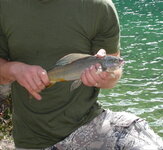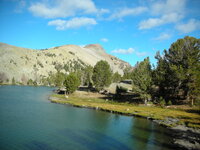You are probably correct, I haven't weighed anything. Thank You for the advice!You are likely to run into some fishing. But it becomes a weight versus fun equation. Some things to consider. How far is your hike in? How much elevation gain? 5 miles with 1000 feet of elevation gain not a big deal. 2 miles with 3000 feet of elevation gain is going to test you.
I’m somewhat skeptical about your estimated pack weight. My day pack for mountain hunting with a rifle weighs close to 30 pounds. If I’m carrying my part of a three person camp its well above 50 lbs. I would suggest actually packing your pack in full, and then deciding if you want to carry fikshing gear.
You can also find fish in small streams and they can sometimes be caught with just a long stick some line and a fly. Think cane pole. Ninja fishing.
Navigation
Install the app
How to install the app on iOS
Follow along with the video below to see how to install our site as a web app on your home screen.
Note: This feature may not be available in some browsers.
More options
Style variation
You are using an out of date browser. It may not display this or other websites correctly.
You should upgrade or use an alternative browser.
You should upgrade or use an alternative browser.
Mid to high altitude lakes.
- Thread starter Slim77
- Start date
It takes a little thought and work to get everything as light as 10oz's. I think you're right, probably most people's backcountry fishing gear is in that 2lb+ weight.It was a guess, I've never weighed fishing gear before, lol. I think I can manage an additional 10oz.
Thank You So Much!!!Sending you a PM.
TaperPin
WKR
- Joined
- Jul 12, 2023
- Messages
- 5,378
Trout up high can’t be too picky when it comes to deciding if they are eating a fly or not, so they are often taken with general purpose flies that don’t exactly match anything - they strike if it’s roughly the correct size and shape.
I generally tell someone new to western fishing to at least bring the flys below. Some of the saddest moments of young adulthood were getting on a hot stream or lake and running out of the fly catching all the fish.
The black wooly bugger about 2” long imitates a type of leach found throughout the west - it stands out, swims nicely and big trout love them. I keep one rigged up about 4’ behind a small water filled casting bubble on an ultra light spinning outfit with 4 lb or 2 lb line (2 lb line actually breaks at 3 lb). If there is a big rock in a river or inaccessible part of a lake - this reaches out nicely and often gets a big strike on the first cast. Strip it in 6” to 12” at a time and it swims well.
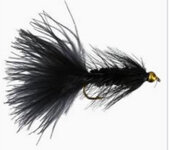
Also for use with a casting bubble or fly outfit is a blue or olive dun as well as the same in black. Sizes 16, 14, and 12 are pretty standard, but I also bring some really small ones that resemble the many small mosquitos and similar looking flying things. It can be fished as a floating fly or waterlogged as a wet. Rainbow stockers love this behind a casting bubble when stripped in fast.
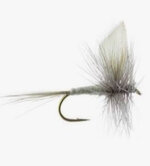
If you only bring one dry fly I’d go with the elk hair cadis in brown as well as black in multiple sizes clear up to a #10. 90% of the time I’ll be using this on small streams in a size 14 because it floats well and is easy to see. Don’t forget fly floatant with these.
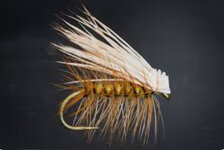
A subsurface fly like the prince nymph or ears hair nymph should be in every fly fishing box. Size 18 & 16 ish. A smaller one without a bead head makes a good dropper fly, or a bead head under the very floaty Chernobyl Ant.


Finally, I’m never without the clunky Chernobyl ant in yellow over black about an inch long or so. When fish are striking at anything that falls in the water, these are twice as tough as an elk hair caddis, easy to see and often effective until most of it has been eaten away. I’ve come into a hot lake full of rainbows and brookies and hooked a dozen fish an hour all around the edges with these.
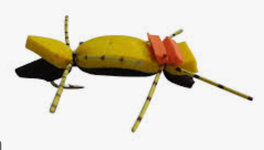
Every region has it’s own special flies and if someone is into matching the hatches more closely there’s nothing wrong with that, but these should be in every Boy Scout’s bag.
I generally tell someone new to western fishing to at least bring the flys below. Some of the saddest moments of young adulthood were getting on a hot stream or lake and running out of the fly catching all the fish.
The black wooly bugger about 2” long imitates a type of leach found throughout the west - it stands out, swims nicely and big trout love them. I keep one rigged up about 4’ behind a small water filled casting bubble on an ultra light spinning outfit with 4 lb or 2 lb line (2 lb line actually breaks at 3 lb). If there is a big rock in a river or inaccessible part of a lake - this reaches out nicely and often gets a big strike on the first cast. Strip it in 6” to 12” at a time and it swims well.

Also for use with a casting bubble or fly outfit is a blue or olive dun as well as the same in black. Sizes 16, 14, and 12 are pretty standard, but I also bring some really small ones that resemble the many small mosquitos and similar looking flying things. It can be fished as a floating fly or waterlogged as a wet. Rainbow stockers love this behind a casting bubble when stripped in fast.

If you only bring one dry fly I’d go with the elk hair cadis in brown as well as black in multiple sizes clear up to a #10. 90% of the time I’ll be using this on small streams in a size 14 because it floats well and is easy to see. Don’t forget fly floatant with these.

A subsurface fly like the prince nymph or ears hair nymph should be in every fly fishing box. Size 18 & 16 ish. A smaller one without a bead head makes a good dropper fly, or a bead head under the very floaty Chernobyl Ant.


Finally, I’m never without the clunky Chernobyl ant in yellow over black about an inch long or so. When fish are striking at anything that falls in the water, these are twice as tough as an elk hair caddis, easy to see and often effective until most of it has been eaten away. I’ve come into a hot lake full of rainbows and brookies and hooked a dozen fish an hour all around the edges with these.

Every region has it’s own special flies and if someone is into matching the hatches more closely there’s nothing wrong with that, but these should be in every Boy Scout’s bag.
Thank you so much, I will definitely pick some of those up!Trout up high can’t be too picky when it comes to deciding if they are eating a fly or not, so they are often taken with general purpose flies that don’t exactly match anything - they strike if it’s roughly the correct size and shape.
I generally tell someone new to western fishing to at least bring the flys below. Some of the saddest moments of young adulthood were getting on a hot stream or lake and running out of the fly catching all the fish.
The black wooly bugger about 2” long imitates a type of leach found throughout the west - it stands out, swims nicely and big trout love them. I keep one rigged up about 4’ behind a small water filled casting bubble on an ultra light spinning outfit with 4 lb or 2 lb line (2 lb line actually breaks at 3 lb). If there is a big rock in a river or inaccessible part of a lake - this reaches out nicely and often gets a big strike on the first cast. Strip it in 6” to 12” at a time and it swims well.
View attachment 722050
Also for use with a casting bubble or fly outfit is a blue or olive dun as well as the same in black. Sizes 16, 14, and 12 are pretty standard, but I also bring some really small ones that resemble the many small mosquitos and similar looking flying things. It can be fished as a floating fly or waterlogged as a wet. Rainbow stockers love this behind a casting bubble when stripped in fast.
View attachment 722051
If you only bring one dry fly I’d go with the elk hair cadis in brown as well as black in multiple sizes clear up to a #10. 90% of the time I’ll be using this on small streams in a size 14 because it floats well and is easy to see. Don’t forget fly floatant with these.
View attachment 722049
A subsurface fly like the prince nymph or ears hair nymph should be in every fly fishing box. Size 18 & 16 ish. A smaller one without a bead head makes a good dropper fly, or a bead head under the very floaty Chernobyl Ant.
View attachment 722046View attachment 722047
Finally, I’m never without the clunky Chernobyl ant in yellow over black about an inch long or so. When fish are striking at anything that falls in the water, these are twice as tough as an elk hair caddis, easy to see and often effective until most of it has been eaten away. I’ve come into a hot lake full of rainbows and brookies and hooked a dozen fish an hour all around the edges with these.
View attachment 722048
Every region has it’s own special flies and if someone is into matching the hatches more closely there’s nothing wrong with that, but these should be in every Boy Scout’s bag.
Broomd
WKR
Nice! I can't wait!Arctic grayling are a nice surprise!
Similar threads
- Replies
- 0
- Views
- 454
- Replies
- 1
- Views
- 378
- Replies
- 49
- Views
- 2K
Featured Video
Latest Articles
- TT#62 Brian Barney Hunting Bulls without Calling
- Hoyt Alpha AX-2 SD Review
- Kuiu Kenai vs Outdoor Vitals Vario Hooded Jacket Review
- Hoyt RX-9 Ultra Review
- Hunting Vampire Bucks & Building an Optics Kit
- Darton Sequel ST2 35 Review
- TT#61 Gear and Skills for Success with Aron Snyder
- Vortex Viper Shotgun Enclosed Micro Red Dot Review
- Howard’s Total Vise Legacy Bow Press
- Tcams, Point Creep, Scouting, & The Hunt Source Podcast


